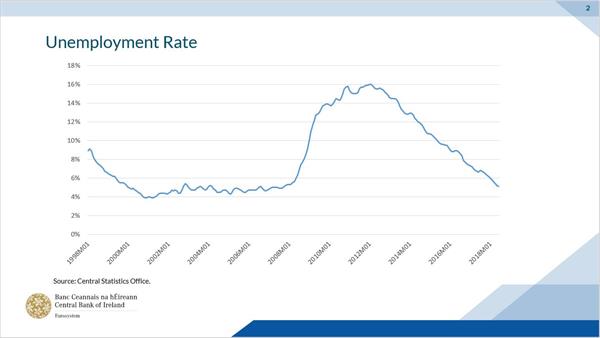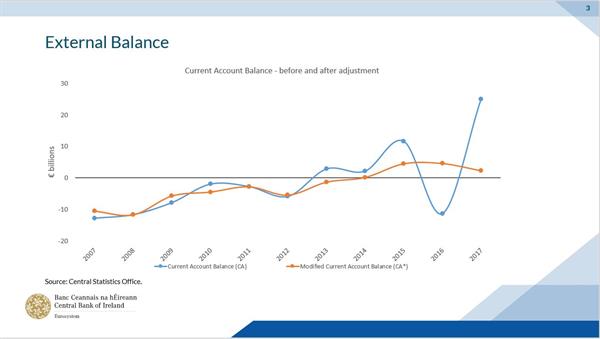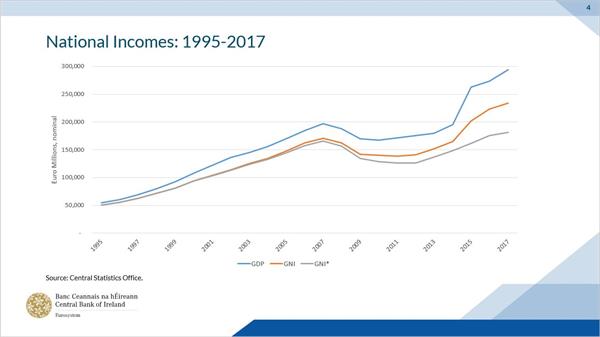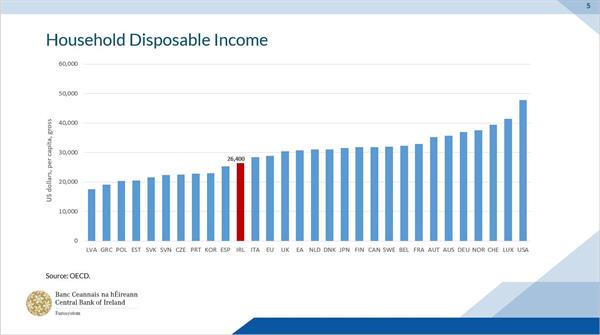Macro-Financial Policies for the Short Term and the Long Term - Governor Philip R. Lane
27 July 2018
Speech

Speaking at the MacGill Summer School
The theme of this session is the challenge of sustaining positive economic performance. At one level, this question is concerned with the avoidance – or, at least, the mitigation – of the severe busts that have followed some previous phases
of economic expansion. At another level, if cyclical volatility is appropriately managed, a more ambitious analysis would also seek to identify the macro-financial policy priorities if Ireland is to attain its long-term goals in terms of sustainable
economic and social development.
In these remarks, I seek to address both dimensions of sustaining positive economic performance. At a conceptual level, it is straightforward to make the distinction between the long-run trend and the short-term cycle, with trend-cycle decompositions
widely employed in economic analysis. As an empirical matter, especially for small and open economies that are some distance from the global frontier, it is not so easy to differentiate in a clean way between short-term and long-term fluctuations
in national income since the international mobility of capital, labour and technology means that a wide range of paths for the economy are feasible (Aguiar and Gopinath 2008, Bluedorn and Leigh 2018).
Still, from a risk management perspective, it would be inappropriate to interpret every uptick in growth as permanent in nature, in view of the very high costs associated with a failure to plan for periodic reversals in economic performance. Equally,
a failure to recognise the role of cyclical factors during phases of sub-par performance can amplify the scale of downturns and damage long-term performance through the non-activation of countervailing counter-cyclical policy measures.
In what follows, I first discuss the management of cyclical volatility, especially in the context of the current state of the Irish economy. Next, I turn to a discussion of the macro-financial policies that will determine Ireland’s ability
to attain its long-term economic and social objectives. Finally, I offer some conclusions from this analysis.
Managing Cyclical Volatility
Ireland has repeatedly suffered periods of economic crisis. In his 2011 Whitaker Lecture, Cormac O’Grada identified five crisis episodes in Ireland: the Economic War of 1934-1938; the Emergency (World War Two); the lost decade of the 1950s; the
1980s fiscal crisis; and the most recent crisis that ignited in 2008 (O’Grada 2011). Furthermore, the vast international literature on economic and financial crises has identified many cases, with the causes and consequences of these episodes
much debated (Kelly 2007, Reinhart and Rogoff 2009, Laeven and Valencia 2013).
A primary lesson from the literature is that crises can emerge for many reasons. While some busts indeed follow boom phases, it is also possible to experience a negative shock that pushes a normally-functioning economy into crisis conditions within
a short time period. In addition, not all booms are followed by busts – the infamous “soft landing” scenario sometimes plays out.
From a policy perspective, it is clearly important to reduce vulnerability to crises by refraining from adverse macro-financial patterns such as persistently-excessive credit growth or unsustainable fiscal imbalances. In addition, especially since
crises can arise even if domestic credit and fiscal conditions are in reasonable shape, it is also important to ensure the macro-financial system is resilient even in the event of severe external shocks.
Currently, the international risk factors that are at the top of our monitoring list include: (i) the risk of an unexpectedly-sharp tightening in international financial conditions, as might be triggered by an increase in risk aversion among investors;
(ii) a downgrading of future global growth prospects, with an international trade war one possibly catalyst; (iii) a shift in global tax practices that adversely affects small countries that host global multinational firms; and (iv) hard Brexit scenarios.
While the first two risk factors are common across all economies, Ireland is especially exposed to the second pair of risk factors.
While it is tricky to attach a probability to any of these scenarios, the potential adverse impact on the Irish economy and Irish financial conditions calls for the accumulation of financial and fiscal buffers that would help to limit the damage.
In relation to financial-sector buffers, the Central Bank is working to ensure that the capital positions of banks are sufficiently strong to withstand the losses that could be triggered by a negative shock. Our policy interventions include the
recent activation of the counter-cyclical capital buffer: in the event of a downturn, this capital buffer can be released, thereby avoiding a pro-cyclical withdrawal of credit supply under adverse conditions1.
In relation to new mortgage lending, our borrower-based measures that impose (flexible) ceilings on loan-to-value (LTV) and loan-to-income (LTI) ratios are designed to limit the risks of over-borrowing by households and over-lending by banks.
More generally, the financial system will be more resilient, the more diversified are sources of funding (across banks, non-banks and markets), the greater the share of equity and other loss-absorbing instruments in liability structures and
the more tightly controlled are maturity mismatches.
Turning to fiscal buffers, the running of budget surpluses that fund some combination of reducing the stock of public debt and building up a rainy day fund of liquid assets would allow the government to implement a stabilising, counter-cyclical
fiscal expansion in the event of a future downturn. If fiscal buffers are not built up in good times, there is a risk of repeating the costly experience of past episodes by which economic downturns were amplified by pro-cyclical fiscal austerity.
The latest data show that the unemployment rate in June 2018 stood at 5.1 percent (see Figure 1). This is substantially below the 5.8 percent average rate for 2018 projected in the government’s Stability Programme Update 2018 (SPU2018) that was published in April. It is also substantially below the (5.3,5.4) range for the unemployment rate during 2019-2021 in the government’s macroeconomic projections. Just two years ago, SPU2016 projected that the average
unemployment rate in 2018 would be 7.0 percent and the range for 2019-2021 would be (6.0, 6.6) percent. The improvement in the labour market is very welcome but does suggest that the economy may be more cyclically-advanced than is assumed in
SPU2018.
Figure 1. Unemployment Rate

Note: Data from Central Statistics Office.
Figure 2. External Balance

Note: Data from Central Statistics Office.
In terms of cyclical indicators, it is also helpful to keep an eye on the current account balance, which captures the gap between national income and national expenditure. Figure 2 shows that the suitably-adjusted measure of the current account
(CA*) – which strips out the impact of balance sheet management by multinational firms – is close to balance, in sharp contrast to the large surplus indicated in the raw current account data. Were the adjusted current account to
move into a persistent, sizeable deficit in the coming years, this would be an indicator of cyclically-elevated macroeconomic environment.
In view of the prospect of further economic expansion during 2019-2021, a revision in the budget balance targets for 2019-2021 (compared to those laid out in SPU2018) may be in order if a cyclically-appropriate policy stance is to be attained. In
particular, the projection of a general government deficit of €350 million in 2019 is not sufficiently ambitious, given the cyclical conditions. As noted in the government’s Summer Economic Statement 2018 (SES2018), a number
of small European countries with similar unemployment rates (and, indeed, much lower public debt ratios) have already been running fiscal surpluses, such that the Irish fiscal projections also look mis-aligned in a comparative perspective.
There are three further reasons to set more ambitious fiscal targets. First, the unexpected surge in corporation tax revenues may have some one-off elements, indicating that some part of these revenues should be categorised as a windfall.
Second, to the extent that the current low interest rate environment is not expected to persist indefinitely, a tighter non-interest budget balance offers protection against future increases in debt servicing costs. Third, the legacy of high
public and private debt levels mean that Ireland is relatively more vulnerable to reversals compared to other countries with healthier public and private balance sheets.
The potential contribution of fiscal policy to macroeconomic stabilisation extends beyond striking the cyclically-appropriate budget balance. Especially for a country in a monetary union, fiscal instruments can be deployed to replicate some
of the features of a national shift in the interest rate or the exchange rate. For instance, adjusting the VAT rate on labour-intensive activities in line with cyclical conditions would proxy a cyclical role for currency adjustment, with
increases in the VAT rate contributing to the moderation of labour market pressures during good times and cuts in the VAT rate helping to boost labour demand during downturns.
Proxies for national interest rate adjustment include shifting the tax rates on investment and consumption in line with cyclical conditions. During upswings, spending pressures can be alleviated by raising taxes on investment and consumption, with
these taxes lowered during slowdowns. Examples include cyclical adjustment of asset taxes in the property sector and a cyclically-sensitive regime for the tax treatment of savings.
In summary, the combination of macroprudential policies and countercyclical fiscal policies can help to mitigate cyclical volatility in the economy. In counterfactual simulations, such policies would have delivered a much milder boom-bust cycle
in the mid-2000s, with a significantly faster recovery from the crisis (Martin and Philippon 2017). Of course, the relative balance between macroprudential and fiscal policies depends on the nature of the cyclical shocks facing the economy:
during a phase of easy international credit conditions, macroprudential policy will be to the fore; if the cycle is being driven by productivity shocks, fiscal policy must take on the lead role in counter-cyclical stabilization.
An important payoff from more successful management of cyclical volatility is that it can allow the policy debate to focus more consistently on the fundamental issues that matter most for long-term economic performance and social development. I
turn to a discussion of the long term in the next section.
Policies for the Long Term
The 2017 annual national accounts released by the Central Statistics Office last week show that headline GDP is 62 percent larger than GNI*, which corresponds to the income that is available to the Irish people (see Figure 3). An important corollary
is that any economic or financial variable that is normally scaled by the size of the economy should be calculated as a ratio to GNI*. For instance, the stock of public debt remains quite elevated at 111 percent of GNI*, while the stock of outstanding
domestic credit is 101 percent of GNI*. It is necessary to bear in mind these high debt-to-income ratios in evaluating any set of long-term policy proposals.
Figure 4 shows household disposable income per capita on a comparable basis (real dollars, adjusted for purchasing power parity) for the set of OECD member countries. These data show that Ireland ranks in mid-table, with living standards far below
the top-tier group of countries. The message is that there remains considerable scope for catch-up growth in Ireland, in addition to the growth potential that can be attained through our contributions to advancing the global technological frontier.
In thinking about the long term, it is also necessary to take into account two fundamental constraints. One is the ageing of the population. According to the Stability Programme Update 2018, the size of the 65-plus cohort is set to nearly
double between 2016 and 2040 (from 629 thousand to 1.21 million), with a corresponding increase in the old-age dependency ratio from 20.9 to 37.1. The ageing of the population has implications for the aggregate growth rate of the economy,
in addition to posing challenges for public and private pensions, the provision of long-term care, the healthcare system and the education system.
The other is the imperative for the world to make the transition to a low-carbon economy, requiring the contraction of carbon-intensive activities and the expansion of environmentally-sustainable activities. With sufficiently-early action, the costs
of this transition may be quite limited, whereas a delayed transition would increase adjustment costs and run the risk of failing to cap the increase in global temperatures within an acceptable range (European Systemic Risk Board 2016).
Accordingly, the debate about long-term priorities should focus on the optimal mix of developmental policies to deliver sustainable growth, while recognising the financial constraints imposed by the legacy of high public and private debt levels and the
imperative of managing the implications of an ageing population and a successful transition to a low-carbon global economy.
Figure 3. National Income: 1995-2017.

Note: GNI* adjusts gross national income to strip out the depreciation of foreign-owned intellectual property assets. Data from Central Statistics Office.
Figure 4. Household Disposable Income
 Note: OECD (2018), Household disposable income (indicator). doi: 10.1787/dd50eddd-en (Accessed
on 20 July 2018).
Note: OECD (2018), Household disposable income (indicator). doi: 10.1787/dd50eddd-en (Accessed
on 20 July 2018).
I will not attempt to offer a comprehensive analysis of these issues. Let me make three points.
First, a well-functioning financial system is essential if these challenges are to be met. Long-term growth relies on effective financial intermediation, with both debt and equity instruments playing an important role in enabling the expansion of
new firms and the funding of capital accumulation. Especially for small countries, a financial system that is open to external investors is essential if the benefits associated with innovation and structural change are to be captured while managing
downside risks (Obstfeld 1994). Accordingly, the further integration of the EU financial system as a shared platform to manage risks across EU-based and global investors can play an important role in sustaining long-term economic performance.
In turn, this requires a legislative framework that strikes the appropriate balance between the protection of creditor rights and the facilitation of an effective resolution and restructuring regime for firms and individuals.
Furthermore, a well-functioning financial system is a necessary element in managing the implications of an ageing population and the transition to a low-carbon economy. In addition to the implications for the State and public pensions systems,
population ageing also requires greater coverage in the provision of private-sector pensions and other age-related financial products such as life insurance and other long-term savings schemes. Since the fees charged are an important determinant
of the overall net return provided to savers, it is essential that the financial system delivers low-cost products for savers. In similar vein, the mis-selling of inappropriate products represent a significant risk for households, such that
a financial system can only be viewed as successful if it is trusted to serve the best interest of consumers. As the financial conduct regulator, we are committed to holding financial firms to account in relation to their conduct. As is made clear
in the report that we published earlier this week, a combination of an improved culture within firms and effective regulation is necessary for trust in the system to be restored (Central Bank if Ireland 2018). Finally, since volatility-related risk
premia are one source of the high price of financial services in Ireland, it is similarly important to recognise that the protection of consumers also requires the effective regulation and supervision of firms and the steady implementation of macroprudential
policies, if these risk premia are to decline over time.
In relation to climate change, the challenge for the international financial system is to manage the contraction of carbon-intensive sectors and the expansion of environmentally-sustainable sectors. A basic step in this direction is for enhanced
disclosure of carbon exposures, such that markets, banks, investors and regulators can make better assessments of the implications of climate change for individual firms. The 2018 action plan on sustainable finance published by the European
Commission contains further measures that are intended to assist the redirection of public and private capital flows towards sustainable investments.
Second, there is increasing recognition that high-quality management in both the private and public sectors is an important determinant of long-term prosperity. While this might seem obvious, the evidence indicates that poor-quality management practices
are widespread and the variation in management performance correlates with differences in outcomes across firms, industries and countries (Bloom et al 2014). In the financial system, we play close attention to the quality of management practices
in our regulated firms in relation to governance systems, operational and IT risks and the embedding of organisational cultures that meet our requirements in relation to serving the needs of the consumers of financial services. For the
public sector, recent international reports have identified scope for improvement in the management of public services and public investment projects (International Monetary Fund 2017, Organisation for Economic Cooperation and Development 2018).
Third, a long-term perspective is necessary in designing the optimal path for public investment. The significant social return that may be expected on high-quality public investment pays off over many decades. At one level, this indicates that it
is important to maintain a steady pace of public investment, since there are few “quick wins.” At another level, it means that public investment cannot be expected to deliver instantaneous improvements in terms of improving productivity
or relieving bottlenecks. Indeed, in the short term, the additional spending pressures associated with an increase in public investment require offsetting balancing fiscal measures if the economy is operating in the neighbourhood of full capacity.
Otherwise, there is the prospect of short-term crowding out, with exporting sectors especially affected by the loss in competitiveness associated with a deficit-financed surge in public investment (Hickey at al 2018). In contrast, a fiscally-neutral
increase in public investment would deliver the long-term gains without inducing short-term overheating.
Conclusions
Successful macro-financial policymaking requires a dual focus on managing cyclical volatility and addressing the strategic challenges that ultimately determine long-term economic and social outcomes.
In relation to the former, both macroprudential and fiscal policies can contribute to cyclical stabilisation. It is clear that credit dynamics are not the primary driver of the current cyclical upswing in Ireland. While the Central Bank is intent
on building the resilience of the financial system to cyclical reversals, it is clear that fiscal policy must take the lead role in ensuring that the current strong growth performance does not tip over into an unsustainable overheating phase. In particular,
more ambitious fiscal surplus targets for 2019-2021 may be advisable in containing cyclical risks.
In relation to the latter, I have emphasised that a well-functioning, trusted financial system is essential if Ireland is to meet its long-term goals in terms of economic and social development, managing the ageing of the population and supporting the
transition to a low-carbon economy. In addition, I have highlighted that improvements in management performance across the private and public sectors (including the financial system and the Central Bank itself) can be an important source of improving
living standards. Finally, I have urged that public investment plans be evaluated in a long-term context, with short-term capacity limits requiring the matching of increases in public investment with counter-balancing fiscal measures if overheating
pressures are to be contained.
References
Aguiar, Mark and Gita Gopinath (2007), “Emerging Market Business Cycles: The Cycle is the Trend,” Journal of Political Economy 115(1), 69-102.
Bloom, Nicholas, Renata Lemos, Raffaella Sadun, Daniela Scur and John Van Reenan (2014), “The New Empirical Economics of Management,” Journal of the European Economic Association 12(4), 835-876.
Bluedorn, John and Daniel Leigh (2018), “Is the Cycle the Trend? Evidence from the Views of International Forecasters,” IMF Working Paper No. 18/163.
Central Bank of Ireland (2018), Behaviour and Culture of the Irish Retail Banking Sector.
European Systemic Risk Board (2016), “Too Late, Too Sudden: Transition to a Low-Carbon Economy and Systemic Risk,” Report No.6 of the Advisory Scientific Committee.
Government of Ireland (2018), Stability Programme Update 2018, Department of Finance.
Hickey, Ronan, Matija Lozej and Diarmaid Smyth (2018), “Irish Government Investment, Finance and the Public Capital Stock,” Central Bank of Ireland Quarterly Bulletin (July).
International Monetary Fund (2017), Ireland: Technical Assistance Report – Public Investment Management Assessment.
Kelly, Morgan (2007), “On the Likely Extent of Falls in Irish House Prices,” Quarterly Economic Commentary (Summer), Economic and Social Research Institute, 42-54.
Laeven, Luc and Fabian Valencia (2013) “Systemic Banking Crises Database,” IMF Economic Review 61(2), 225-270.
Martin, Philippe and Thomas Philippon (2017), “Inspecting the Mechanism: Leverage and the Great Recession in the Eurozone,” American Economic Review 107(7), 1904-1937.
Obsteld, Maurice (1994), “Risk-Taking, Global Diversification and Growth,” American Economic Review 84(5), 1310-1329.
O’Grada, Cormac (2011), “Five Crises,” UCD Centre for Economic Research WP 11/12.
Organisation for Economic Cooperation and Development (2018), Economic Survey of Ireland 2018.
Reinhart, Carmen and Kenneth S. Rogoff (2009), This Time Is Different: Eight Centuries of Financial Folly, Princeton University Press
1 The capital positions of banks are determined by the combination of: (i) the regulatory minimum level specified in legislation; (ii) the capital requirements and guidance set by supervisors, which takes into account firm-specific
information; and (iii) the systemic buffers set by the macroprudential authority. For the main Irish banks, the supervisor is the Single Supervisory Mechanism (SSM), led by the ECB, while the Central Bank of Ireland is the macroprudential
authority. In addition the counter-cyclical capital buffer, the other systemic buffer currently activated is the so-called O-SII (Other Systemically Important Insitutions) buffer, which takes into account the systemic impact of individual
firms. The resilience of the banking system has also been reinforced by the introduction of the recovery and resolution regime under which banks can be recapitalised through the bailing-in of investor funds or shut down in a structured
manner that limits contagion to the rest of the financial system.
2 While the SSIA scheme that ran over 2001/2002 to 2006/2007 introduced the concept of savings incentives, it operated for a fixed time period of five years, rather than being opened and closed in response to cyclical conditions.